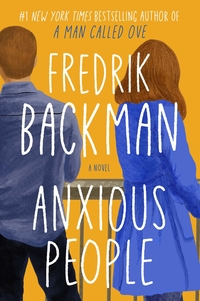My Friends by Fredrik Backman
 Monday, May 5, 2025 at 10:01AM
Monday, May 5, 2025 at 10:01AM 
Published in translation by Atria Books on May 6, 2025
Fredrik Backman has such a gentle sense of humor and writes from such a humane point of view that he might be unique among contemporary authors. My Friends examines life from the perspectives of four fifteen-year-old friends, from the perspectives of two of the friends after they reach middle age, and from the perspective of a snarky 17-year-old girl on the cusp of adulthood. The story revolves around the last perfect summer than the teenage friends spent together and the effort that one of those friends, now well into adulthood, makes to help the teenage girl.
One of the four friends is now a famous artist who, having nearly reached the age of 40, is about to die. The artist signs his paintings C. Jat but is known throughout the novel as “the artist” or Kimkim. His most famous painting is of the sea — that’s all rich art collectors notice, apart from the price tag — but to Louisa, the 17-year-old, it is a painting of kids on a pier that rich collectors never seem to notice. Louisa loves to draw. She has a postcard of the painting, but she sneaks into an art show where the painting is being sold because she needs to see it in person.
When the police chase her (they assume that she intends to deface the painting with the spray paint in her bag), Louisa hides in an alley next to a homeless bum who kindly misdirects the cops. The bum is quickly revealed as the famous artist when they begin to paint graffiti on an alley wall together.
The artist has been living with Ted, one of the childhood friends. The novel implies that they are lovers but their relationship is built on love regardless of how they might express it. The artist instructs Ted to buy the painting of the sea and give it to Louisa so she can sell it and live a good life as she pursues her own art. Louisa wants to reject the gift because she has always lost everything — including her parents and a best friend who died. She is certain she will lose any money that might come from the sale of the painting.
Ted wants to rid himself of Louisa but his loyalty to the artist compels him to assure that Louisa takes the painting. They continue their argument on a train journey that will eventually take them to the town where Ted, the artist, and their two friends — Joat and Ali — spent their last summer together. Along the way, Ted tells Louisa the story of that summer. The story is about childhood friendships and lasting bonds, but it is also about child abuse and how friends save each other. Some of the story is about death, the ways people process the loss of a friend or family member. And it’s about way in which friends recognize and encourage talents that young people might otherwise be too insecure to pursue.
Backman is given to platitudes. He hits the reader with new ones on nearly every page. “The world is full of miracles, but none greater than how far a young person can be carried by someone else’s belief in them.” “That’s the worst thing about death, that it happens over and over again. That the human body can cry forever.” “Because art is a fragile magic, just like love, and that’s humanity’s only defense against death.” And so on. Some of them are insightful. Some are schmaltzy. Many are redundant. Still, a cheerful author with good intentions can brighten days made dim by the relentless onslaught of insults that passes for discourse in America.
Because the book is crowded with platitudes, it takes some time to tell a simple story. The plot involves Ted’s journey with Louisa to a destination where she can find assistance selling the painting. Each of them tries to abandon the other along the way, but they learn that they are not good at abandoning people. Ted takes a beating — not the first in his life and the reason he doesn’t like to go outside. Louisa shows off her aptitude for theft. As the journey unfolds, Ted tells Louisa about the kids in the painting, all of whom are damaged in some way. Their goal that summer is to make the artist paint something (they execute various schemes so they can acquire paints and a canvas) because they know that unchaining his potential is the only way he will survive the harsh reality of life.
The platitudes add up to a theme. Backman argues that we are at our best as children because we understand the importance of close personal bonds, loyalty, and trust. We love our friends as we will never love again. In adulthood, we spend our lives trying to regain the wisdom we had as children. We fail miserably. We don’t mean what we say and we don’t say what we mean. But we try to improve because regaining the childhood capacity to love is all that will save us. The life-changing power of art is another theme. The ending brings a pay-it-forward theme.
In my experience with kids, as well as my memory of being one, teens rarely express profound thoughts. Nor are they as kind, or at least as aware of the need for sensitivity of their friends’ feelings, as the kids in Backman’s world. Still, it’s a fun story and, notwithstanding an excess of schmaltzy platitudes, My Friends teaches lessons that merit the reader's consideration.
RECOMMENDED

